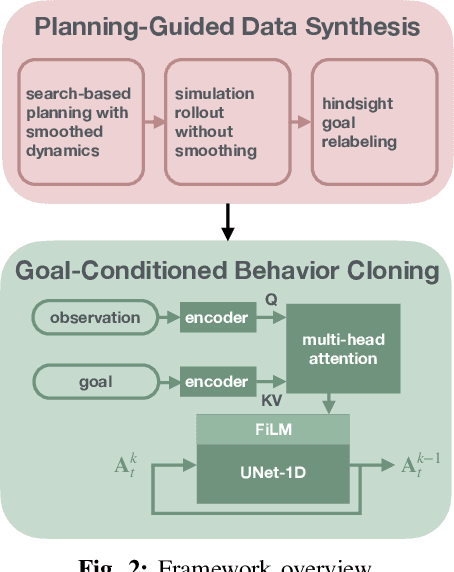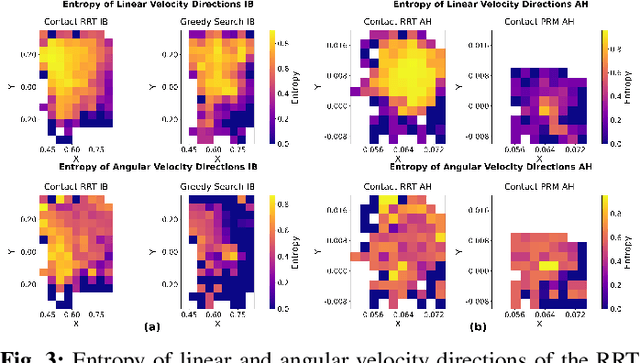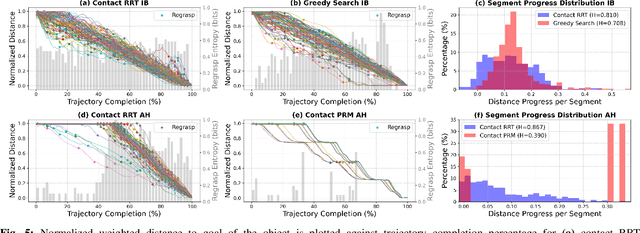Jiuguang Wang
Versatile Loco-Manipulation through Flexible Interlimb Coordination
Jun 09, 2025Abstract:The ability to flexibly leverage limbs for loco-manipulation is essential for enabling autonomous robots to operate in unstructured environments. Yet, prior work on loco-manipulation is often constrained to specific tasks or predetermined limb configurations. In this work, we present Reinforcement Learning for Interlimb Coordination (ReLIC), an approach that enables versatile loco-manipulation through flexible interlimb coordination. The key to our approach is an adaptive controller that seamlessly bridges the execution of manipulation motions and the generation of stable gaits based on task demands. Through the interplay between two controller modules, ReLIC dynamically assigns each limb for manipulation or locomotion and robustly coordinates them to achieve the task success. Using efficient reinforcement learning in simulation, ReLIC learns to perform stable gaits in accordance with the manipulation goals in the real world. To solve diverse and complex tasks, we further propose to interface the learned controller with different types of task specifications, including target trajectories, contact points, and natural language instructions. Evaluated on 12 real-world tasks that require diverse and complex coordination patterns, ReLIC demonstrates its versatility and robustness by achieving a success rate of 78.9% on average. Videos and code can be found at https://relic-locoman.github.io/.
ASHiTA: Automatic Scene-grounded HIerarchical Task Analysis
Apr 10, 2025Abstract:While recent work in scene reconstruction and understanding has made strides in grounding natural language to physical 3D environments, it is still challenging to ground abstract, high-level instructions to a 3D scene. High-level instructions might not explicitly invoke semantic elements in the scene, and even the process of breaking a high-level task into a set of more concrete subtasks, a process called hierarchical task analysis, is environment-dependent. In this work, we propose ASHiTA, the first framework that generates a task hierarchy grounded to a 3D scene graph by breaking down high-level tasks into grounded subtasks. ASHiTA alternates LLM-assisted hierarchical task analysis, to generate the task breakdown, with task-driven 3D scene graph construction to generate a suitable representation of the environment. Our experiments show that ASHiTA performs significantly better than LLM baselines in breaking down high-level tasks into environment-dependent subtasks and is additionally able to achieve grounding performance comparable to state-of-the-art methods.
Physics-Driven Data Generation for Contact-Rich Manipulation via Trajectory Optimization
Feb 27, 2025



Abstract:We present a low-cost data generation pipeline that integrates physics-based simulation, human demonstrations, and model-based planning to efficiently generate large-scale, high-quality datasets for contact-rich robotic manipulation tasks. Starting with a small number of embodiment-flexible human demonstrations collected in a virtual reality simulation environment, the pipeline refines these demonstrations using optimization-based kinematic retargeting and trajectory optimization to adapt them across various robot embodiments and physical parameters. This process yields a diverse, physically consistent dataset that enables cross-embodiment data transfer, and offers the potential to reuse legacy datasets collected under different hardware configurations or physical parameters. We validate the pipeline's effectiveness by training diffusion policies from the generated datasets for challenging contact-rich manipulation tasks across multiple robot embodiments, including a floating Allegro hand and bimanual robot arms. The trained policies are deployed zero-shot on hardware for bimanual iiwa arms, achieving high success rates with minimal human input. Project website: https://lujieyang.github.io/physicsgen/.
Should We Learn Contact-Rich Manipulation Policies from Sampling-Based Planners?
Dec 12, 2024



Abstract:The tremendous success of behavior cloning (BC) in robotic manipulation has been largely confined to tasks where demonstrations can be effectively collected through human teleoperation. However, demonstrations for contact-rich manipulation tasks that require complex coordination of multiple contacts are difficult to collect due to the limitations of current teleoperation interfaces. We investigate how to leverage model-based planning and optimization to generate training data for contact-rich dexterous manipulation tasks. Our analysis reveals that popular sampling-based planners like rapidly exploring random tree (RRT), while efficient for motion planning, produce demonstrations with unfavorably high entropy. This motivates modifications to our data generation pipeline that prioritizes demonstration consistency while maintaining solution diversity. Combined with a diffusion-based goal-conditioned BC approach, our method enables effective policy learning and zero-shot transfer to hardware for two challenging contact-rich manipulation tasks.
Planning-Guided Diffusion Policy Learning for Generalizable Contact-Rich Bimanual Manipulation
Dec 03, 2024



Abstract:Contact-rich bimanual manipulation involves precise coordination of two arms to change object states through strategically selected contacts and motions. Due to the inherent complexity of these tasks, acquiring sufficient demonstration data and training policies that generalize to unseen scenarios remain a largely unresolved challenge. Building on recent advances in planning through contacts, we introduce Generalizable Planning-Guided Diffusion Policy Learning (GLIDE), an approach that effectively learns to solve contact-rich bimanual manipulation tasks by leveraging model-based motion planners to generate demonstration data in high-fidelity physics simulation. Through efficient planning in randomized environments, our approach generates large-scale and high-quality synthetic motion trajectories for tasks involving diverse objects and transformations. We then train a task-conditioned diffusion policy via behavior cloning using these demonstrations. To tackle the sim-to-real gap, we propose a set of essential design options in feature extraction, task representation, action prediction, and data augmentation that enable learning robust prediction of smooth action sequences and generalization to unseen scenarios. Through experiments in both simulation and the real world, we demonstrate that our approach can enable a bimanual robotic system to effectively manipulate objects of diverse geometries, dimensions, and physical properties. Website: https://glide-manip.github.io/
Is Linear Feedback on Smoothed Dynamics Sufficient for Stabilizing Contact-Rich Plans?
Nov 14, 2024



Abstract:Designing planners and controllers for contact-rich manipulation is extremely challenging as contact violates the smoothness conditions that many gradient-based controller synthesis tools assume. Contact smoothing approximates a non-smooth system with a smooth one, allowing one to use these synthesis tools more effectively. However, applying classical control synthesis methods to smoothed contact dynamics remains relatively under-explored. This paper analyzes the efficacy of linear controller synthesis using differential simulators based on contact smoothing. We introduce natural baselines for leveraging contact smoothing to compute (a) open-loop plans robust to uncertain conditions and/or dynamics, and (b) feedback gains to stabilize around open-loop plans. Using robotic bimanual whole-body manipulation as a testbed, we perform extensive empirical experiments on over 300 trajectories and analyze why LQR seems insufficient for stabilizing contact-rich plans. The video summarizing this paper and hardware experiments is found here: https://youtu.be/HLaKi6qbwQg?si=_zCAmBBD6rGSitm9.
NL-SLAM for OC-VLN: Natural Language Grounded SLAM for Object-Centric VLN
Nov 12, 2024



Abstract:Landmark-based navigation (e.g. go to the wooden desk) and relative positional navigation (e.g. move 5 meters forward) are distinct navigation challenges solved very differently in existing robotics navigation methodology. We present a new dataset, OC-VLN, in order to distinctly evaluate grounding object-centric natural language navigation instructions in a method for performing landmark-based navigation. We also propose Natural Language grounded SLAM (NL-SLAM), a method to ground natural language instruction to robot observations and poses. We actively perform NL-SLAM in order to follow object-centric natural language navigation instructions. Our methods leverage pre-trained vision and language foundation models and require no task-specific training. We construct two strong baselines from state-of-the-art methods on related tasks, Object Goal Navigation and Vision Language Navigation, and we show that our approach, NL-SLAM, outperforms these baselines across all our metrics of success on OC-VLN. Finally, we successfully demonstrate the effectiveness of NL-SLAM for performing navigation instruction following in the real world on a Boston Dynamics Spot robot.
GenDP: 3D Semantic Fields for Category-Level Generalizable Diffusion Policy
Oct 23, 2024



Abstract:Diffusion-based policies have shown remarkable capability in executing complex robotic manipulation tasks but lack explicit characterization of geometry and semantics, which often limits their ability to generalize to unseen objects and layouts. To enhance the generalization capabilities of Diffusion Policy, we introduce a novel framework that incorporates explicit spatial and semantic information via 3D semantic fields. We generate 3D descriptor fields from multi-view RGBD observations with large foundational vision models, then compare these descriptor fields against reference descriptors to obtain semantic fields. The proposed method explicitly considers geometry and semantics, enabling strong generalization capabilities in tasks requiring category-level generalization, resolving geometric ambiguities, and attention to subtle geometric details. We evaluate our method across eight tasks involving articulated objects and instances with varying shapes and textures from multiple object categories. Our method demonstrates its effectiveness by increasing Diffusion Policy's average success rate on unseen instances from 20% to 93%. Additionally, we provide a detailed analysis and visualization to interpret the sources of performance gain and explain how our method can generalize to novel instances.
Continuously Improving Mobile Manipulation with Autonomous Real-World RL
Sep 30, 2024



Abstract:We present a fully autonomous real-world RL framework for mobile manipulation that can learn policies without extensive instrumentation or human supervision. This is enabled by 1) task-relevant autonomy, which guides exploration towards object interactions and prevents stagnation near goal states, 2) efficient policy learning by leveraging basic task knowledge in behavior priors, and 3) formulating generic rewards that combine human-interpretable semantic information with low-level, fine-grained observations. We demonstrate that our approach allows Spot robots to continually improve their performance on a set of four challenging mobile manipulation tasks, obtaining an average success rate of 80% across tasks, a 3-4 improvement over existing approaches. Videos can be found at https://continual-mobile-manip.github.io/
Jacta: A Versatile Planner for Learning Dexterous and Whole-body Manipulation
Aug 02, 2024Abstract:Robotic manipulation is challenging due to discontinuous dynamics, as well as high-dimensional state and action spaces. Data-driven approaches that succeed in manipulation tasks require large amounts of data and expert demonstrations, typically from humans. Existing manipulation planners are restricted to specific systems and often depend on specialized algorithms for using demonstration. Therefore, we introduce a flexible motion planner tailored to dexterous and whole-body manipulation tasks. Our planner creates readily usable demonstrations for reinforcement learning algorithms, eliminating the need for additional training pipeline complexities. With this approach, we can efficiently learn policies for complex manipulation tasks, where traditional reinforcement learning alone only makes little progress. Furthermore, we demonstrate that learned policies are transferable to real robotic systems for solving complex dexterous manipulation tasks.
 Add to Chrome
Add to Chrome Add to Firefox
Add to Firefox Add to Edge
Add to Edge